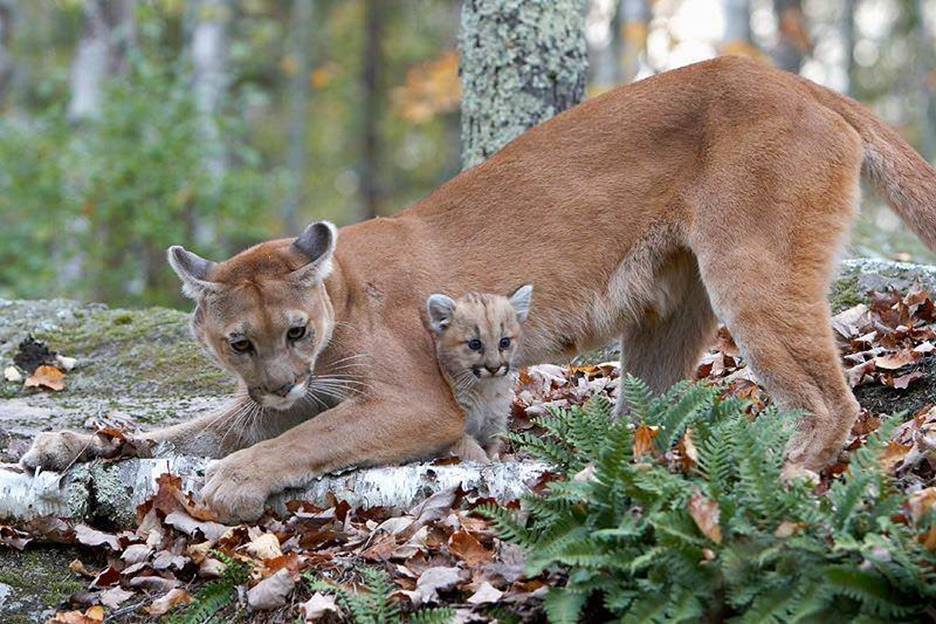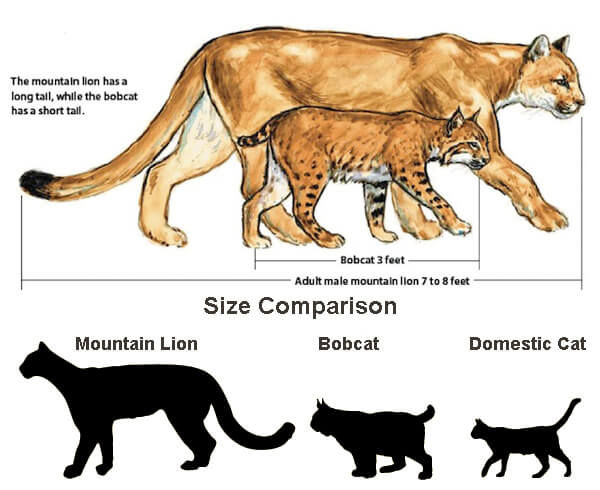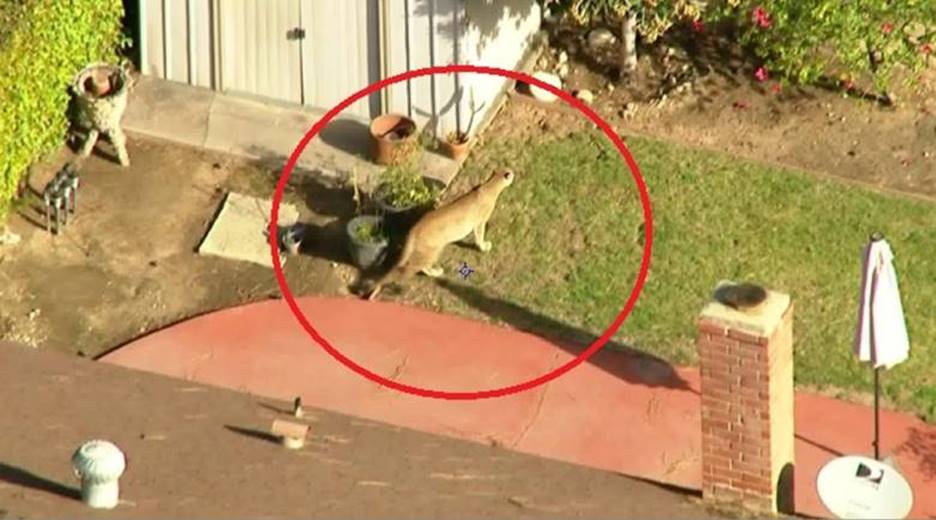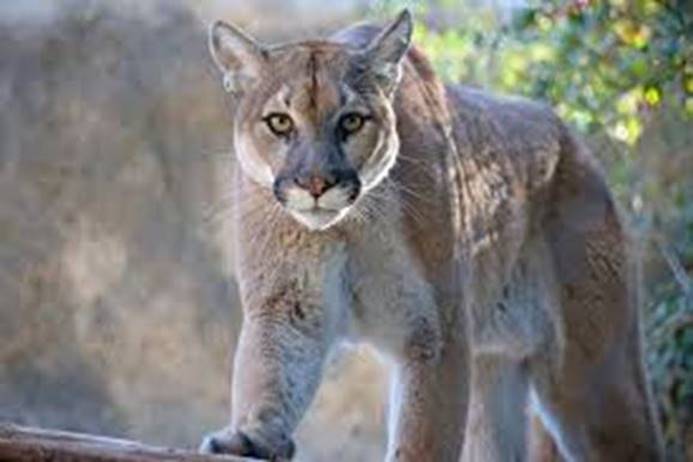he morning was fair and the day proved favorable to our operations . . . in the early part of the day two of our men fired on a panther, a little below our encampment, and wounded it; they informed us that it was very large, had just killed a deer partly devoured it, and in the act of concealing the ballance as they discovered him. – Meriwether Lewis, May 16, 1805., Garfield County MT. Location deemed Cougar Camp.
The mountain lion is a wide ranging large cat found throughout the western U.S. and into southern Canada extending to southern Chile and Argentina. In recent years there have been increased frequency of sightings in the mid-west and eastern U.S. including on the suburbs of Chicago and in Connecticut, Illinois, and Kentucky. Several years ago the Washington Department of Fish and Wildlife had calls of cougar sightings in the Magnolia neighborhood of Seattle, near the large Discovery Park. They scoffed at this until someone sent them a photo. It was a lone cat that likely found its way into town via the Burlington Northern Railroad tracks. It was captured and relocated to a more suitable location.
Mountain lions, also known as puma, cougar, or catamount, are the second largest cat in North America, surpassed only by the jaguar, which occasionally is found in southern Arizona and New Mexico. Other than humans, no animals prey upon cougars but they often come in conflict with other carnivores over their kills including gray wolf, black bear, and grizzly bear. Coyotes are known to gang up and chase away young cougars.

Cougars are generalists, eating just about anything they can catch, which is part of their success story. Their diet can vary widely with geography. In Yellowstone National Park their diet is up to 90% deer and elk. A study on Vancouver Island, B.C. indicated that raccoons bade up to 28% of their diet with harbor seals and deer (24% each), river otter (10%), California sea lion (7%), mink (4%), and unidentified prey (3%). In Central America mid-sized animals, such as capybara, are preferred and ungulates account for only about 35% of their diet. Guanaco, peccary, vicuna, rhea, and wild turkey are on the menu for cougars further south.

Cougars have one litter every two or three years, depending on habitat and weather conditions. Females raise the young along and the juveniles will remain with their mom for two years. In the wild cougars generally live 8 – 13 years. Males are about 8 feet long from nose to tip of tail and weigh between 120 – 220 lbs.
Cougars are solitary animals and only the mother and her young live together. A home range for a male cougar can vary from 58 – 386 square miles with female home ranges half this size. Cougars can be quite adept at living on the fringe of civilization. In California studies in San Diego have shown they make use of the extensive series of canyons and shrubland throughout the city, even using culverts to cross highways. The problem, however, is a limited population relatively isolated from other animals, resulting in limited genetic diversity.

Cougars can be dangerous. A bicyclist was killed on a U.S. Forest Service road near North Bend, WA in May of 2018 and a hiker was killed in the Mt. Hood National Forest in Oregon on September 11, 2018. There have been numerous non-fatal attacks on people over the past 25 years.
So what should you do if you encounter a mountain lion while out hiking? Mountain Lion Guidelines
· Make yourself as large as possible and pick up children
· Make noise
· Maintain eye contact, do not run, act defiant. Throw rocks, wave your arms.
· Slowly back away.
· If attacked, fight back, protect your neck and throat.
I’ve only seen a mountain lion in the wild once. I was out on a Native Plant Society walk on Table Mountain outside Ellensburg, WA and I had my young daughter with me. After the walk we drove out to (really!) Cougar Rock, that had a high perch over the valley.
We were eating lunch and I scanned the big talus field below us and found what I first thought was a deer coming up the slope, thinking that was odd. But it was a cougar. I tried to give Chloe the binoculars and point her in the right direction but at 8 years old she couldn’t find it. It wandered up the slope about 100 yards away and into the trees.
About 16 years ago I was working on the Klamath Hydro project that spans Oregon and California. We were using deer carcasses to lure in carnivores to our camera stations and we able to get some nice cougar photos. Occasionally the cougars would tear off the deer hind quarters that we had secured to a tree with bailing wire.
We were also conducting spotted owl surveys in some very remote areas, accessible via quads. One of our colleagues, Kirk, who was a solid field biologist but a bit quirky, was out alone at night checking his designated owl hooting locations. He stopped at one and found a dead deer that was partially covered up with dirt – a cougar kill. He wisely decided to leave.
Several miles away he stopped at his second site, hooted for owls, and finding none went back to his quad parked along the dirt road. For the heck of it he shinned his strong flashlight down the road and saw two eyes glowing in the distance. So he decided to investigate and walk towards them. I’m not sure I would have done the same.
It was a mountain lion walking towards him. Kirk just kept walking. They stopped about 50 feet apart. The cat sits down. They look at each other for a while. Kirk doesn’t want to turn his back on the cat so he starts making noise and waving his arms around. The cat gets up and slowly, with that nonchalance cat saunter, walks towards the forest and finally into the tree line.
Kirk starts walking back to his quad, but after 100 feet turns the light around and sees the cougar following him. He repeats his efforts and chases the cougar back into the forest and this time briskly walks back to the quad checking behind him regularly, makes it to the quad, and drives away.
On the way back he stops at his first owl station and finds two more cougars gnawing on the deer carcass. Kirk decides enough is enough and turns the quad towards home.
